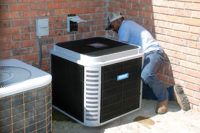The most important factor to remember when making any recommendation is that the best air cleaner is the one that fulfills the needs of your customer. As the needs of your customers vary, so will the recommended air cleaner.
Performance, price, and maintenance need to be taken into consideration when making a sincere recommendation.
It is also important to understand the market, and have a solid knowledge base of various filtration devices and their capabilities. To help you get started, following are answers to some questions you may already be asking yourself.
Common Questions
Why do people need an indoor air filtration device?With incidents involving allergies and asthma on the rise, organizations like the American Academy of Allergy, Asthma and Immunology are recommending an indoor air cleaner as one part of a complete allergen reduction strategy. An air cleaner will help to reduce the 10 million to 30 million particles contained in 1 cu ft of air.
Air filtration devices also help extend the life of heating and cooling equipment by keeping system components clean and dust-free. Many agree that a quality forced-air system should have a quality filtration system.
Other reasons might include a better understanding of the contaminated state of our indoor and outdoor air conditions, and the desire for a reduction in household cleaning and maintenance.
What is the difference between an air filter and an air cleaner?
Simply put, air cleaners actually clean the air passing through them, while air filters merely trap or filter particles.
Confusion often occurs when you look at test results for each. Air filters — when tested using ASHRAE’s dust spot efficiency test — are less than 20% efficient, whereas air cleaners are more than 20% efficient.
Because air filters are considerably less efficient, an arrestance test is used to measure their capabilities. While an air filter may appear to have great arrestance test results, it will always be less than 20% efficient in the dust spot test.
What types of air filters are available?
Panel air filters are often equipped on furnaces and air conditioning equipment, with the main purpose being prevention of malfunctions caused from dust and dirt.
Materials used in the construction of panel filters range from fiber glass to aluminum. Arrestance-tested efficiency can be as high as 72%. However, dust spot-tested efficiency ranges from 2% to 15%.
Although the cost of panel filters is relatively low, a maximum amount of maintenance is required. Fiber glass filters need to be replaced every two to three months, while aluminum media filters require a cleaning every six months.
Panel filters are the best choice when price is the main concern and only minimum protection is desired.
Electrostatic filters are easily installed with heating-cooling equipment and are intended as a replacement to the panel filter. These filters operate on the principle of static electricity: As air passes through the filter, an electrostatic charge is created which attracts microscopic particles such as pollen, mold, and dust.
Arrestance-tested efficiency can be as high as 94%, but dust spot-tested efficiency ranges from 5% to less than 20%. The cost of electrostatic filters is only slightly more than panel filters, but once again, cleaning as often as every two to three months is required.
These filters are the best choice when your customers are looking for a permanent air filter with protection slightly greater than a panel filter. Price is still a major consideration.
Air filters are good tools to keep large particles out of a home’s heating and cooling system. Smaller particles, however, will still have the ability to escape through the filter and find their way into the forced-air system.
Air filters provide occupant minimum protection and are not the best choice for a customer in need of an indoor filtration device to provide allergy relief.
What types of air cleaners are available?
Electronic air cleaners are usually installed on the return duct of a forced-air system, although portable models are also available. Particles passing through are given an electrical charge, forcing an attraction to oppositely charged collection plates.
Based on results from the ASHRAE dust spot efficiency test, these cleaners have an initial efficiency between 70% to 90%. However, efficiency levels drop considerably as the air is cleaned.
Maintenance varies, but usually involves washings every one to three months to retain high efficiency ratings.
Electronic cleaners use electricity to operate. Over the course of operation, ozone is generated. These cleaners are more costly than air filters and require professional installation.
Electronic cleaners are the best choice when there is a need to capture very small particles; the homeowner is willing to perform frequent maintenance; and installation cost is not an obstacle.
Non-electronic or media air cleaners are also installed on the return duct of a forced-air system; portable models are available as well. The high-efficiency, pleated media combines the four principles of filtration — straining, impingement, interception, and diffusion — to remove particles.
Results from the ASHRAE dust spot efficiency test indicate a fully loaded media air cleaner will reach 80% efficiency. And on particles 3.0 microns or larger, which is the size of most pollens and spores, a media air cleaner will reach 99% efficiency.
These cleaners require professional installation, but because no electrical wiring is required, the installed cost is lower. Replacing the media every one to two years is required.
Media air cleaners are a good choice when an air cleaner is desired for allergy relief and low maintenance.
High-efficiency particulate air (HEPA) cleaners used in residential applications are only found in portable models. In order to receive the designation, HEPA cleaners must remove 99.97% of all particles 0.3 microns in size. Particles are removed with the use of a high-efficiency pleated media.
Residential HEPA cleaners are expensive and usually only recommended for the super-sensitive. The media requires replacement every one to three years and is also expensive.
HEPA cleaners are a good choice for a customer with extremely severe allergies and the willingness to spend money for added relief.
Air cleaners are the best choice for a customer in need of a filtration device to provide allergy relief. A good air cleaner will also provide protective maintenance for heating and cooling equipment.
Although the initial cost is more expensive, most customers will realize, over time, that a quality air cleaner truly does pay for itself.





